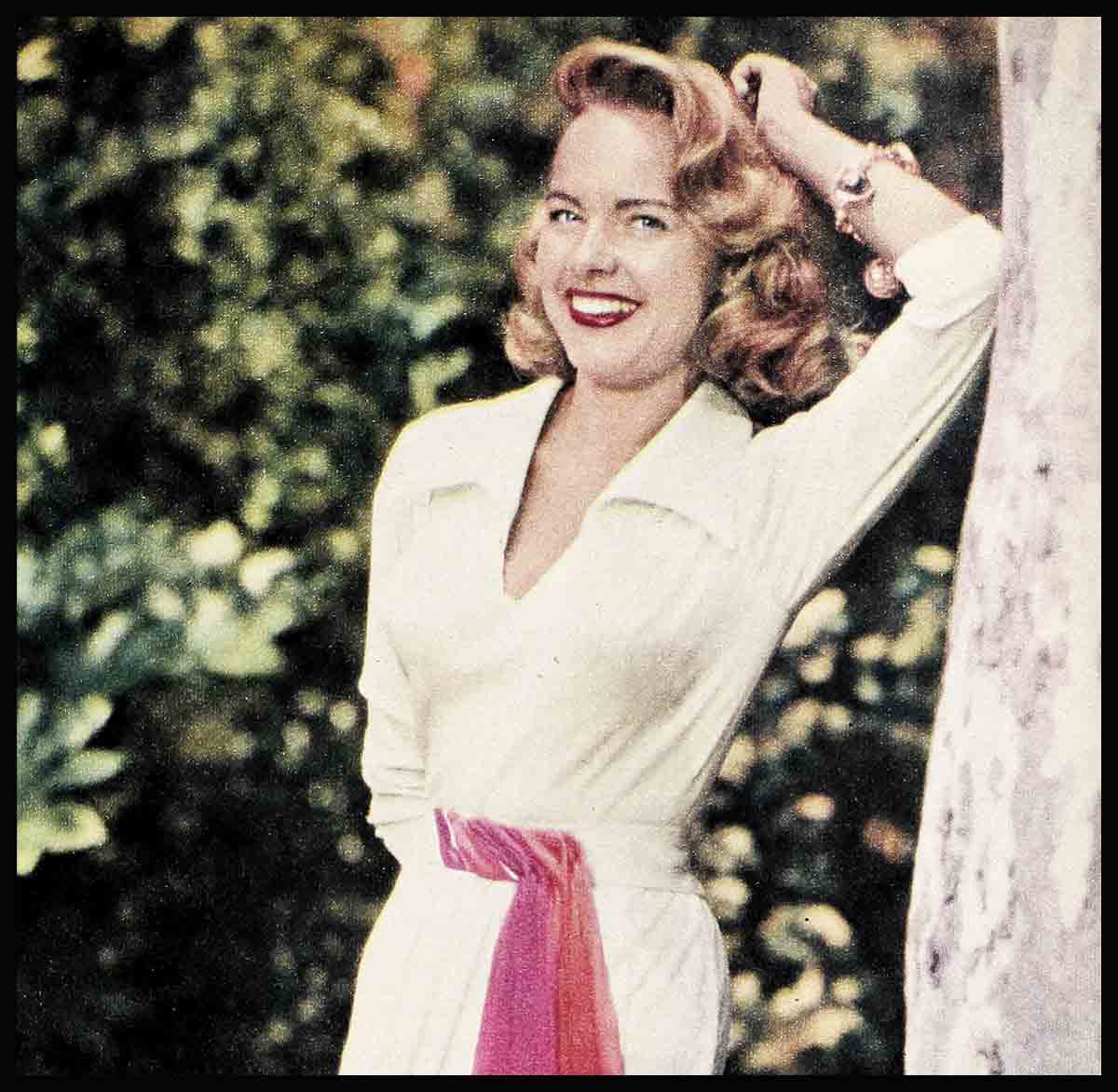
“Why, I Did Not!”—Terry Moore
This may surprise you, but Terry Moore never did any of those things they said she did. Nope, not one of them. And no one was more surprised than Terry at the way things just kept happening to her.
Now I’ve known, liked and rooted for Terry Moore for a lot of years—’way back to the days when it looked like she might marry Howard Hughes. I’m still her fan—now more than ever. My B.W. (Beautiful Wife, you know) likes her, too, and that makes it final for me. You know how women are—especially about other beautiful women.
But everybody knows that for years Terry Moore’s name was practically synonymous with headlines. Now that she’s married to a swell guy named Eugene McGrath, I decided to track her down and see whether the “new” Terry might admit she’d been a teeny-weeny bit publicity-minded in some of those head- line incidents. You remember . . . Korea and the ermine Bikini . . . Istanbul and the lifted skirt picture . . . Las Vegas and the peekaboo-top gown.
So Terry, Gene and I met at Toots Shor’s in New York for a late dinner and I began pinning her down. What had I expected? Apologies? Regrets? A vow never to make another headline? Well, hardly.
Terry’s voice held a note of reproach as she said, “I don’t hunt headlines—they hunt me.” This was accompanied by a large, wide-eyed glance from very blue eyes. “In fact,” she continued, “headlines began happening to me at the age of five!” And, more reproachfully still, “You don’t think I was dreaming up publicity stunts for myself at that age?
“At five,” recounted Terry, pausing in her attack on a hamburger steak, “I followed a lion tamer into a cage of lions in Los Angeles. He went in to feed the lions and I followed him in. The biggest lion made a swipe at me and missed me. I had no idea of the danger. I just wanted to play with the pussycat.”
Her husband, Gene, an insurance and investment specialist who has homes in Panama City, Panama, Caracas, Venezuela, and Hendersonville, North Carolina, said to Terry, “Tell him about the press-agent situation.”
“Oh, yes!” exclaimed Terry. “They’ve always said I have a lot of press agents working for me. But actually it wasn’t until my marriage to Gene that I could afford a press agent.”
“I thought she should have one,” explained Terry’s dark-haired, businesslike spouse, “to straighten out some of these misunderstandings.”
Then Terry tossed in a thought that may explain a lot of things. “I love adventure,” she said, “and I go places where things are happening. Then things happen to me.
“But I don’t think I mind. Because I don’t want to get into a rut. If you white-wash your life too much, it gets kind of gray and it’s not interesting.”
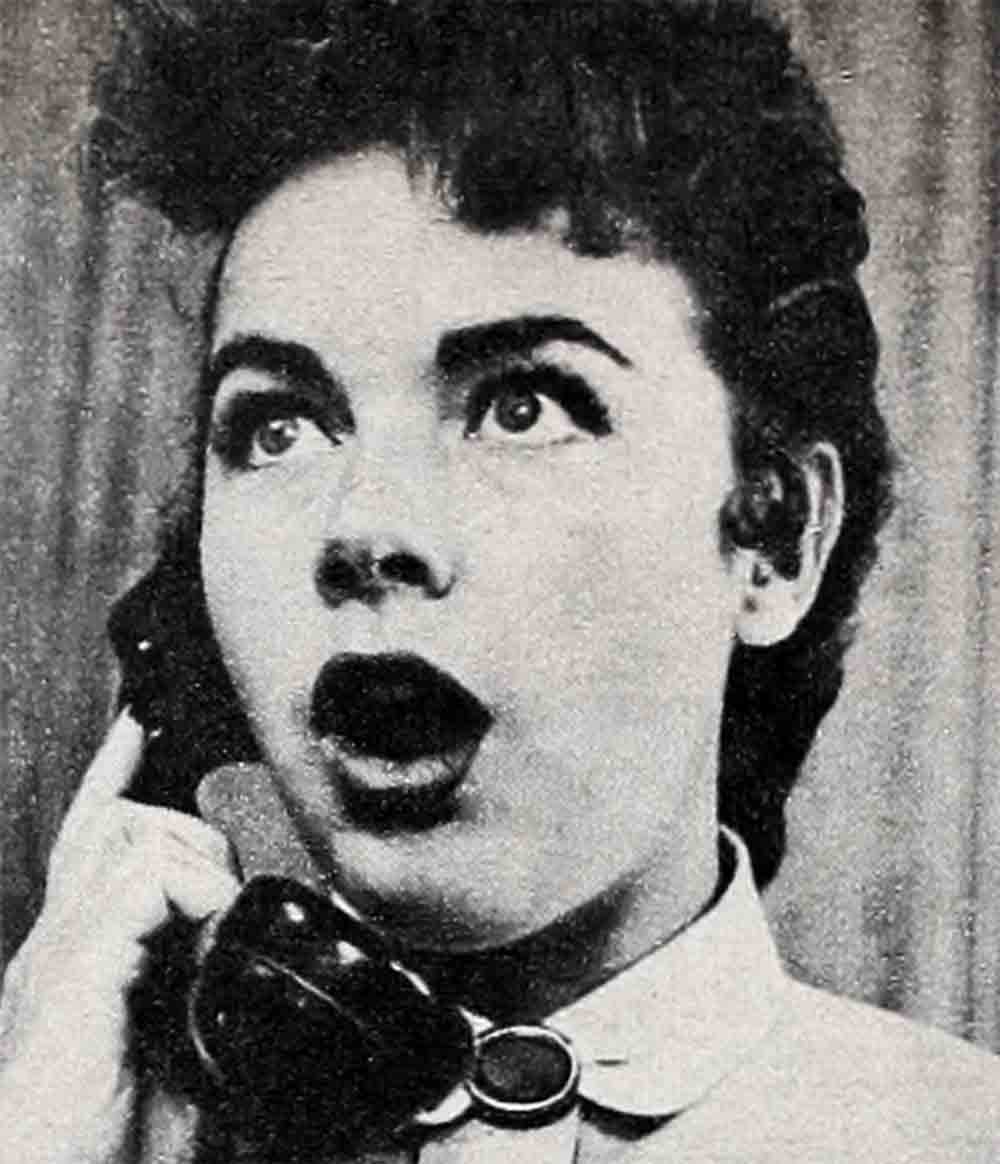
Terry had finished her hamburger, which had been preceded by honeydew melon. Quietly, while the waiter was removing the plate, Gene ordered more honeydew melon for her. As the waiter brought it, Terry looked up in surprise at her bridegroom and said, “How did you know I wanted more melon?”
As she dug into it, she said, “But out of everything bad comes some good, and the headlines have helped in one sense. My name’s become so well-known that I’m given opportunities to do roles on TV that I wouldn’t get otherwise.”
Laughingly, she added, “When some quiet little girl is mentioned for a possible role, people might say, ‘Who ever heard of her?’
“I guess they couldn’t say that about me.”
After the lion took a swipe at five-year-old Terry, which got her name in the papers, she began getting publicity as a child radio actress. Her name also got into the high-school paper.
“I was always in it with something that was happening to me—although I never tried to be,” Terry told me. “Finally I became the editor so I could keep my name out!”
As a sample of her contention that things are always happening to her, Terry cited her visit to San Diego a few years ago when her hotel room caught fire.
“My room was all filled with water when the photographers arrived,” she said. “That ‘wasn’t my fault, certainly.”
“You didn’t set the fire?” I asked jokingly.
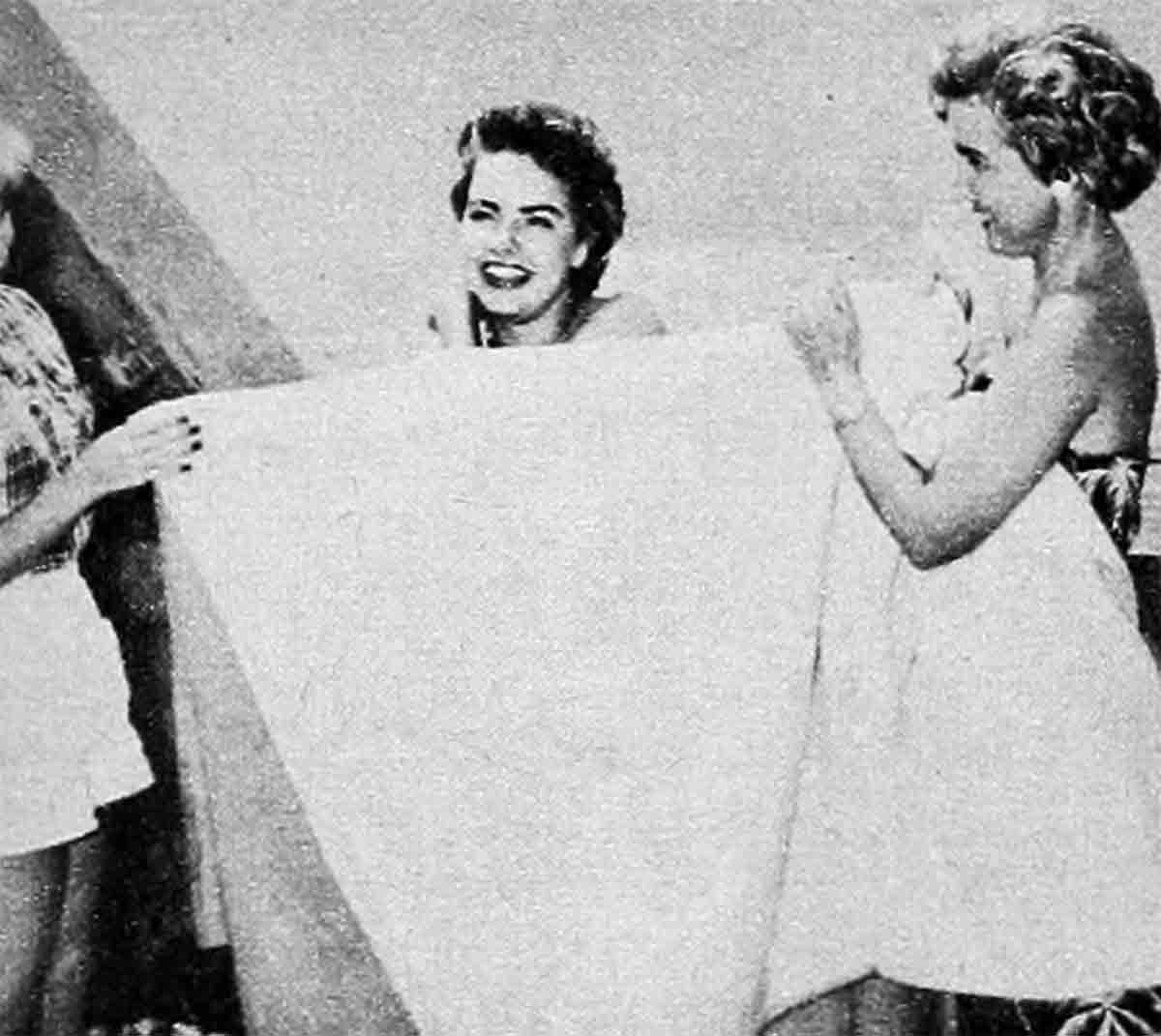
Terry laughed. “If I had the brains to dream up all the things that have happened to me accidentally, I could make millions of dollars in publicity work. People are always saying, ‘My, how clever you were to have thought of that stunt.’
“Clever! Things just happened . . . and I can hardly accept any credit or discredit. Maybe it’s because I’ve always said what I felt and what I thought. Some people in our business feel they should clam up on everything. Well, I don’t clam up. It’s not my personality!”
Her husband was discreetly quiet on this point. But as our conversation continued, a curious thing occurred. I asked Terry again about the celebrated “ermine Bikini” fiasco in Korea . . .
It’s always been her contention—and I’ve agreed with her—that, first of all, the bathing suit she wore wasn’t a Bikini.
It was just an ermine-trimmed suit. Somebody referred to it as a Bikini, and the name stuck. But when you look at a picture of the suit, you can see there was nothing at all to get excited about.
Yet as Terry began talking about the incident to me, she referred to the bathing suit as “my ermine Bikini.”
I practically gasped at this, and so did her husband.
“You just called it a Bikini,” Gene said.
“Oh, I’ve heard it so much, I now say it myself,” shrugged Terry.
She raced on in the conversation and once again referred to the controversial garment as “my Bikini.”
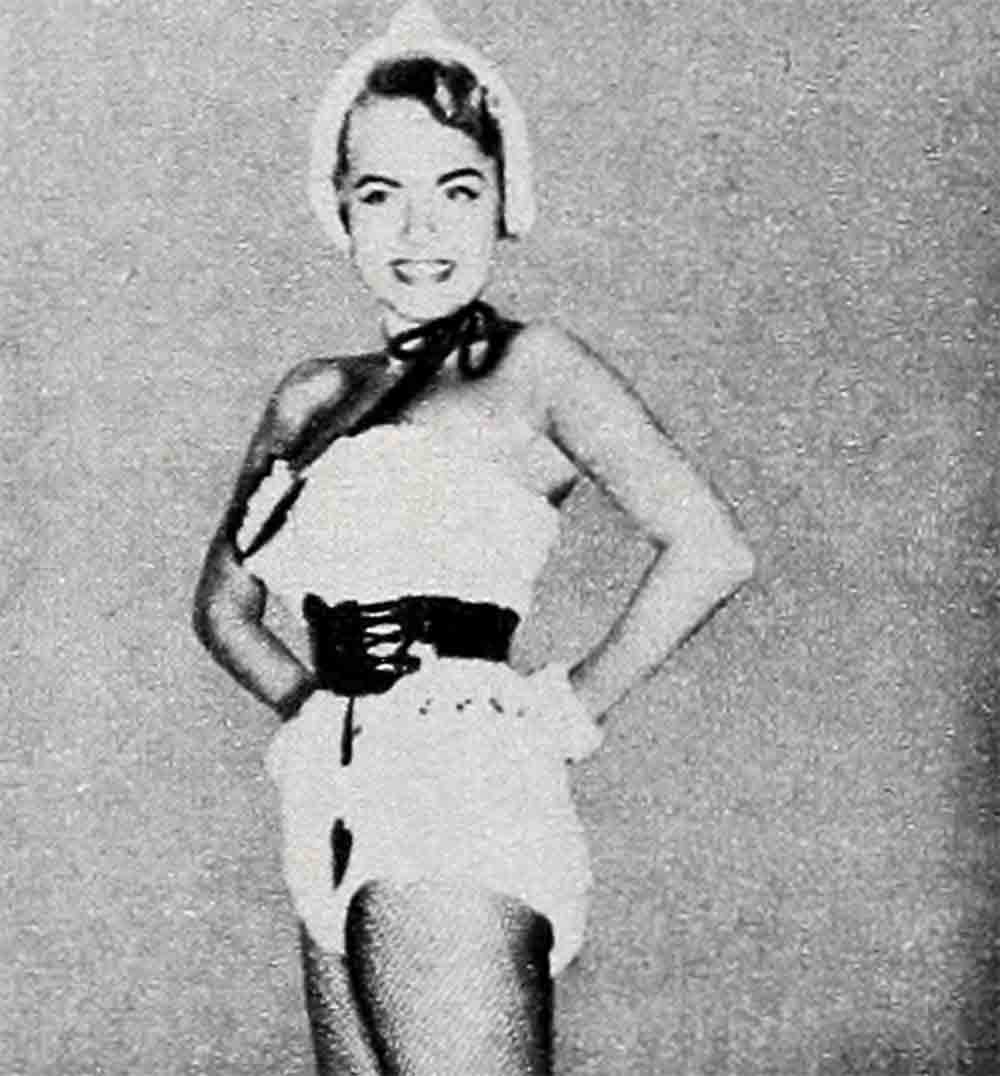
This time we both laughingly corrected her.
“My bathing suit then!” she said, good-humoredly.
Oh no, Terry insisted, when I brought it up, it hadn’t received the Bikini name from her. No, she had never inadvertently called it that (as she had just now).
“I didn’t even know what a Bikini was when this all started,” Terry said.
Undoubtedly you recall the headlines about that and perhaps some of the details. But let Terry refresh your memory.
“Debbie Reynolds and some of the other girls had gone to Korea to entertain the troops, and they thought it was fun to wear GI (Government Issue) clothes.
“It was fun—for them—but the GIs didn’t like it so much because they hadn’t seen girls in a while and they wanted to see them looking feminine.”
So Terry let it be known in an interview that she was going to wear a GI trench coat or overalls—but that when she took it off, she’d be revealed in a bathing suit. She even had the speech planned.
“This is the new GI underwear,” she was going to say.
It did sound funny, and pictures of the suit were published ahead of the trip (with Terry in it).
“But when I got on the plane to leave for Korea, Bill Smith of 20th’s publicity department—he was once married to Ethel Merman—came out and said to me, ‘Look, don’t wear the ermine suit. George Murphy [who was in charge of entertainment for the troops] is getting all sorts of protests through the mail about you and—suit demoralizing the boys at the front.’ ”
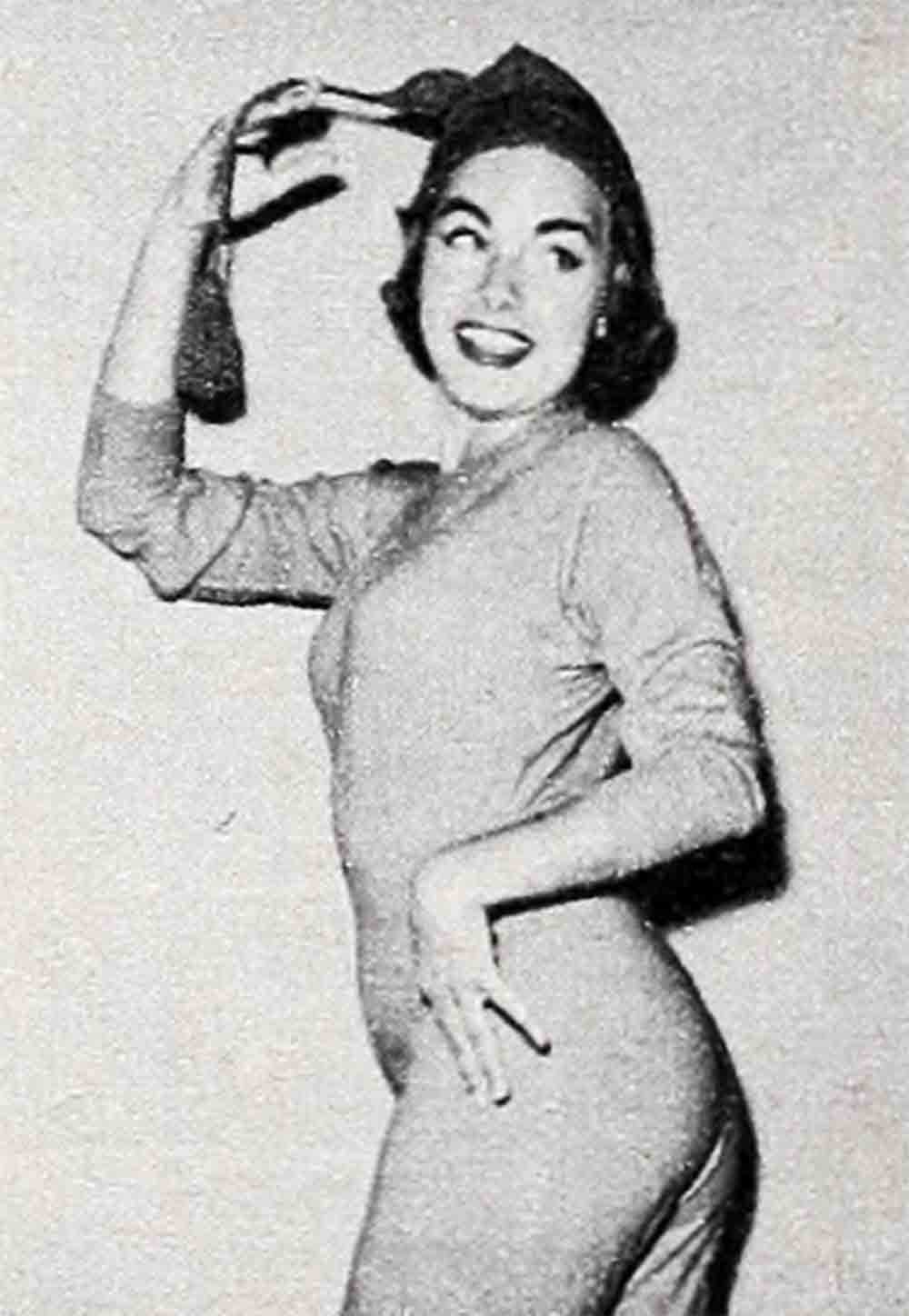
Terry was pretty confused when she got to Korea. Some of the Army brass wanted her to wear the suit, and the Gls certainly wanted her to wear it. “Let’s let the chaplains have a look at it,” suggested one of the generals.
“It’s all right,” said the chaplains.
Hollywood disc jockey Johnny Grant, who was in charge of the tour, also said, “It’s okay. I tell you, it’s okay,” as Terry recalls it.
So Terry wore the suit. The story went out on the wire. Then some of the Washington brass got mad and George Murphy said, “Send her home.” But the brass in Korea stood by Terry and she finished out the tour.
It took a long time, though, for Terry to live that down. For a while she carried pictures of the suit in her purse, and when anybody brought up the subject, she would whip out the pictures and demand: “Is there anything wrong with that?” Most people conceded that there wasn’t.
Terry’s clincher to the argument always is her recollection of what the Gls themselves said: “Look, if we’re old enough to fight a war, aren’t we old enough to see a girl in a bathing suit?”
Photoplay could not have picked anyone better informed than I am about the famous “lifted-skirt incident,” in Istanbul, that has also haunted Terry. Because I was in Istanbul at the time—and I suffered a little bit from it.
’Twas in June, 1955, that a junket took many of us to Turkey to attend the opening of the fabulous Istanbul Hilton Hotel.
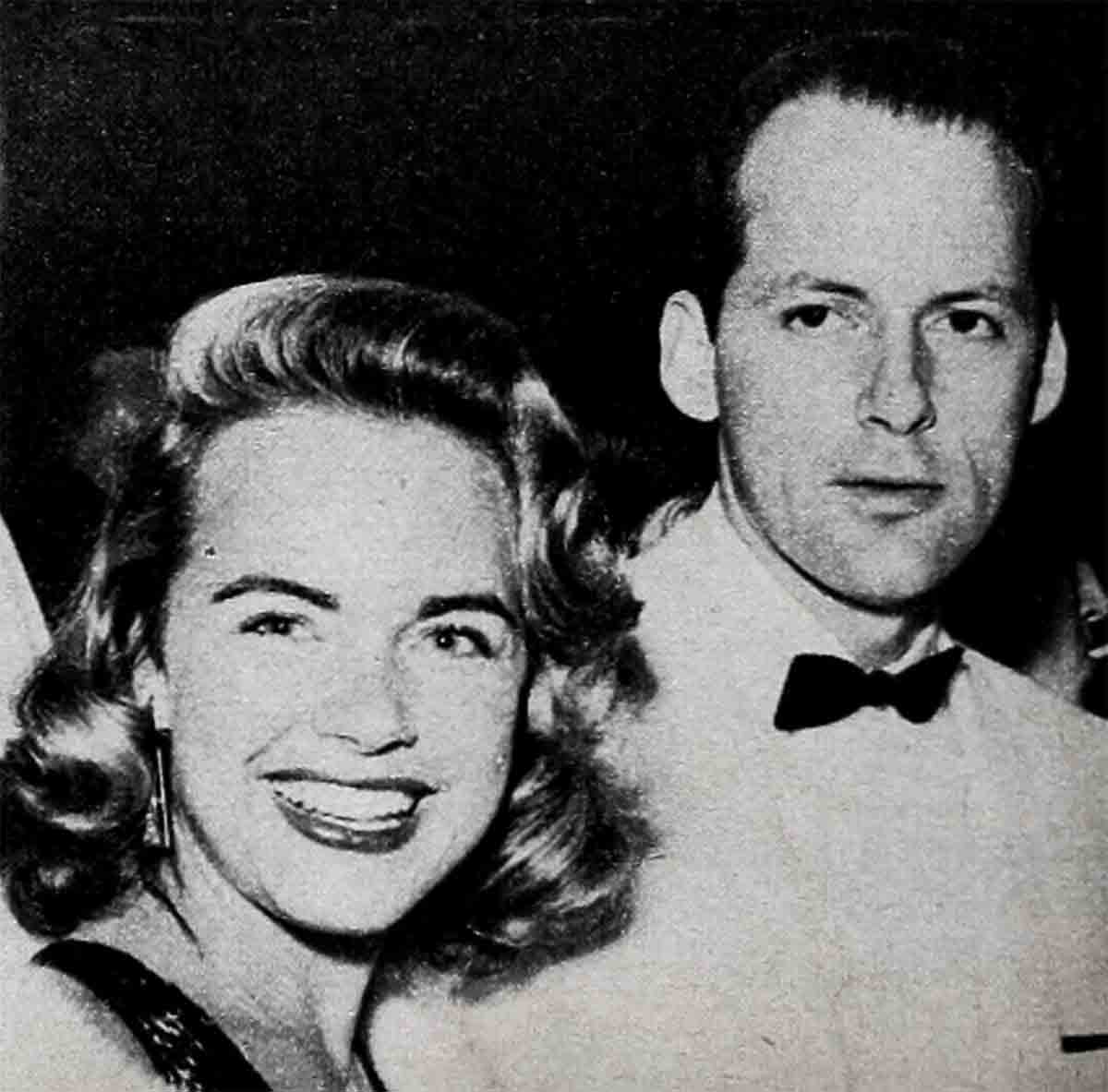
One morning, I came downstairs to hear everybody in the lobby saying, “Did you see that Terry Moore picture?”
I hadn’t. Somebody produced a copy of the Istanbul newspaper Milliyet which had Terry displayed all over the right side of the front page.
“They tricked her!” were my first words.
I’m an amateur photographer, and I’ve been around cameramen for many years. I know how some of them like to trick girls into uncomplimentary poses.
I got a cab and went over to see Ercument Karacan, young publisher of the Milliyet. He was sorry for all the furor. He said it was all a horrible mistake and he wanted to apologize to Terry.
“We want to make peace and clear her reputation,” he pleaded. “You arrange us to meet her again and apologize to her.”
Terry was too busy right then talking to New York lawyer Florence Shientag, who happened to be on the trip. She’d been given sedatives by Dr. Rex Ross, Hollywood surgeon who was also on the junket.
Realizing the scandal possibilities of the story, and considering myself a friend of Terry’s, I didn’t want to pay any attention to it.
From the hotel lobby I phoned one American columnist who felt the same way. “But what about ——?” this columnist said, naming another columnist on the trip.
I phoned the second columnist who said, “I’m going to file a story. It’s news.”
So I cabled one, too, and before long the story was in all the American newspapers. The controversial picture, strangely enough, in itself wasn’t bad. But the editors decided that it didn’t look very artistic—so they had it retouched. The retouched version came out looking quite overexposed—and that’s the one that got into print.

A Turkish reporter who interviewed Terry when the picture was taken told me that he had a hot debate with his bosses about running the picture. He told them it was unfair to her. He lost the argument.
A “peace conference” came about, and Terry was given a negative to burn so the picture would be out of existence.
But one of the editors of the paper whispered to me, “We didn’t give her the real negative.”
I obtained a copy of the “original, un-retouched” picture and carried it back to America with me. Inasmuch as I had just returned from Istanbul, people all over Europe asked to see the picture, which hadn’t been printed in America.
“Here it is,” I would say, producing it magically from my pocket.
The people who asked to see it would a and then they would say: “Is this all?”
It, too, wasn’t anything to get excited about—until it had been retouched. Later on, I learned that Terry was angry at me for cabling a story home. She protested that in my story I had said she was “kicked out of Korea.”
Terry didn’t understand about cable language, that you generally write short, incomplete sentences. I’d never even gone into the Korean incident in my cable. But somebody in the office had rehashed Terry’s history and had remembered just enough about the Bikini to think she’d been “kicked out of Korea.”
It took us quite ‘a while to settle that.
Terrible Terry’s never going to play the Garbo bit about publicity and interviews—but she was reticent about publicizing her marriage to Gene McGrath. I can testify to that from personal experience, too.
About January 15, 1956, I was in Los Angeles, on the way to the opening of the Dallas Hilton Hotel.
“We tried to get Terry Moore to go to the opening, too,” an official of the chain told me, “but we couldn’t find her.”
“Couldn’t find her!” I said. “Is Terry up to something?”
“It’s very strange,” the official said. “We phoned her father in Hollywood, but he said he didn’t know how to get in touch with Terry. He said she was in New York somewhere staying with a girl named Peggy, but he couldn’t think of her last name.”
“That’s odd. What about her mother?”
“He said her mother was with her. We checked with Celebrity Service and all that but couldn’t find her.”
When I returned to New York from Dallas, I heard a rumor that Terry had been secretly married in Las Vegas on New Year’s Day.
One source told me “positively,” but all others that knew Terry denied it or knew nothing about it. I phoned her father in Hollywood and he claimed to know where Terry was—though he wouldn’t tell me insisted she wasn’t married.
Continuing to check on it, I traced Terry to Panama City.
Yes, she had been seen there that very day—with Gene McGrath. But, so far as anybody knew, they weren’t married.
I couldn’t get Terry on the phone. So I sent a cable. It was returned “undelivered.” Terry had checked out of the hotel in Panama City, leaving no forwarding address.
I wrote the story of the probable marriage based on what I knew. A few days later it was confirmed. Terry and Gene McGrath had actually slipped out, during dinner with Eddie Fisher and Debbie Reynolds in Las Vegas, to get married. They came back to the dinner table and didn’t mention it. They didn’t even tell her father. So, insists Terry, her father was in complete ignorance of her marriage when he denied the story to me.
The point is, Terry and Gene passed up a lot of powerful publicity by keeping their marriage a secret.
A New Year’s Eve wedding in Las Vegas with Eddie Fisher and Debbie Reynolds present would have been a tremendous story. But Terry and Gene passed it up. The “new Terry” and her bridegroom didn’t want to start their marriage that way.
Maybe Terry was scared of Las Vegas a little because of her earlier experience with the “nude-looking” dress.
Marlene Dietrich had just won world-wide publicity with a naked-looking gown, and now the Hotel Flamingo hoped Terry would go her one better.
“The dress was dyed so the top would look nude,” Terry said, “but the dress was very heavy—twenty-six pounds. Since I was thoroughly covered in the gown, they drew some lines here and there on the pictures so I looked distorted in shape, and half-naked. I was so furious, I wouldn’t wear the dress again—and I paid $3,000 for it!
“I hardly talked to the management during the whole engagement, and I told them I wouldn’t sign a contract to go back.”
And so there you have it. Terry would do it all over again—because, as you have seen, she never did anything. Things just kept happening to her.
Maybe it doesn’t sound believable at first, but when you check back over the incidents, you realize she’s got a strong argument.
In the future, Terry will probably be seen frequently in pictures because, as she points out, “I’m one of the few actresses under regular contract now at 20th.”
She recently finished “Between Heaven and Hell,” based on the book The Day the Century Ended.
“It took me only two weeks,” she says. “The studio arranged for me to do all my scenes in a bunch because of my traveling schedule with Gene.”
Now that she’s trying to live in three places at once, commuting among Hollywood, Caracas, and Panama City, things will surely be happening to Terry again.
I saw another sample of how things happen to her a few weeks ago. She phoned me from Washington and said she was. arriving in New York that evening. I mentioned that Dean Martin and Jerry Lewis were closing that night at the Copacabana and that it would be a rather historic evening.
“I’d like to go,” Terry said.
“I don’t think you could get a table this late. The place has been sold out for weeks,” I said.
“Call Danny Stradella of Danny’s Hide-a-way,” she suggested. “They always have a table at the Copacabana openings and closings.”
So I did. It didn’t look hopeful. Danny did have a table for fourteen people, but he already had eighteen or twenty people who wanted to go. Poor Terry.
As I arrived at the Copacabana myself, I saw lines of people who’d been waiting—many of them good customers who had been turned away.
Terry’s out of luck tonight,” I told myself.
The lights went up, the orchestra played, Dean and Jerry came out—and there sat Terry Moore and Gene McGrath. Ringside. Closer to the show than anybody else in the club.
I had an impulse to dash over to them, because there was one other question I wanted to ask. I wanted to ask Gene how he planned to go about keeping things from happening to Terry in the future. But then I realized it wasn’t any use. How can a guy keep things from happening to a girl to whom things just keep happening?
Anyway, they looked too happy. And besides, I had my story.
THE END
—BY EARL WILSON
Terry Moore in “Between Heaven and Hell.”
It is a quote. PHOTOPLAY MAGAZINE NOVEMBER 1956




